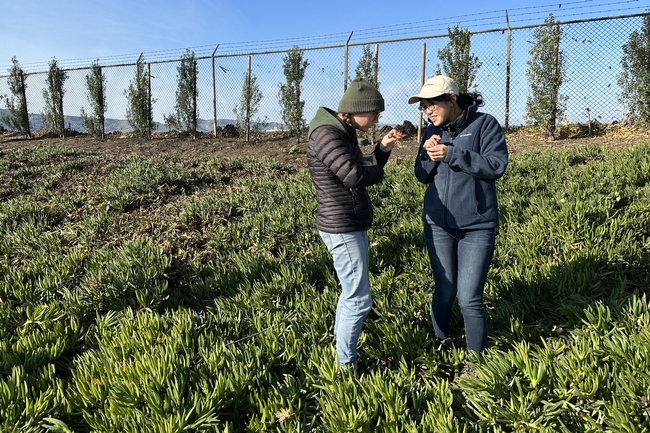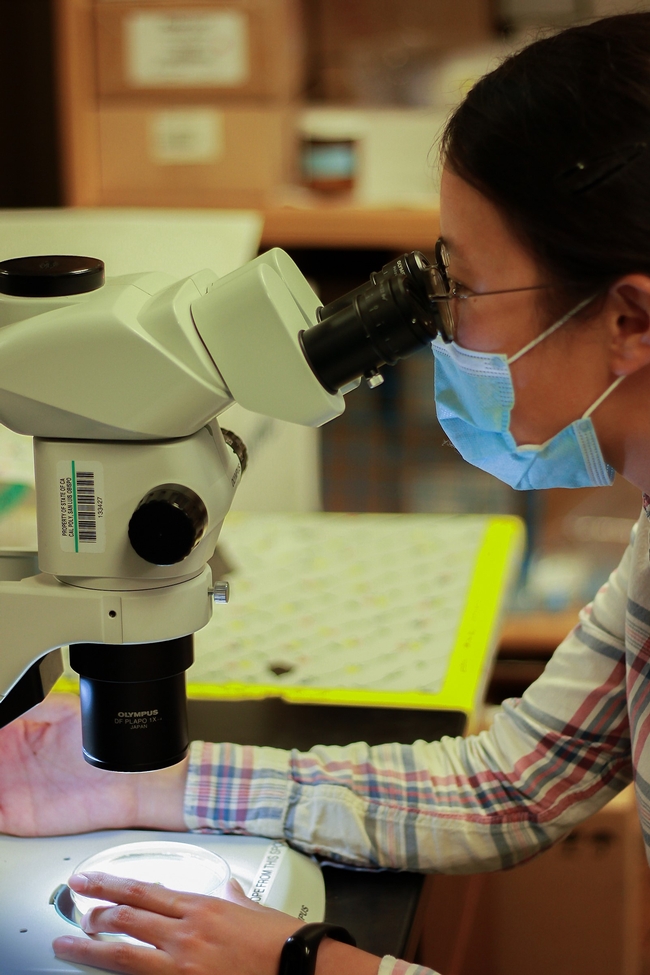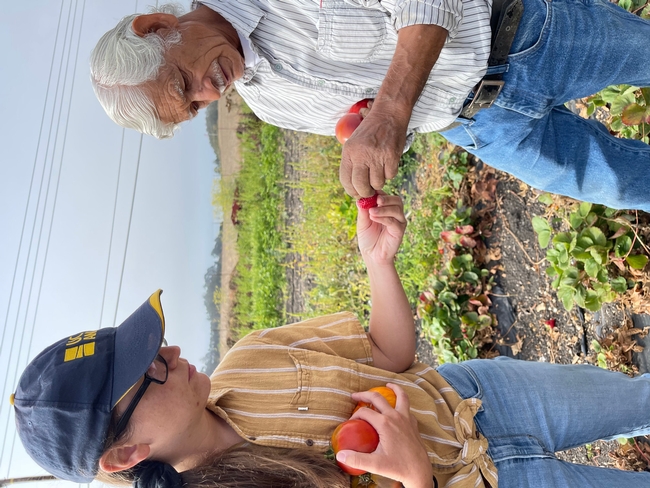
Posts Tagged: Monterey County
New UCCE advisors bring fresh ideas to protect lettuce from INSV, Pythium wilt
Salinas Valley lettuce growers lost about $150 million in 2022 due to diseases
A stormy winter could portend another devastating year for the lettuce industry in the Salinas Valley, which saw approximately $150 million in lost gross revenue in 2022 due to INSV (impatiens necrotic spot virus) and associated diseases. Recent drenching rains might mean more weeds – overwintering “reservoirs” for the tiny insect, the Western flower thrips, that carries INSV.
Or the extreme precipitation could benefit growers, as thrips in the soil – during their intermediate stage of development – might be drowned in the waterlogged fields.
As with so many aspects of the INSV crisis, the ultimate effects of flooded fields on thrips populations remain unknown.
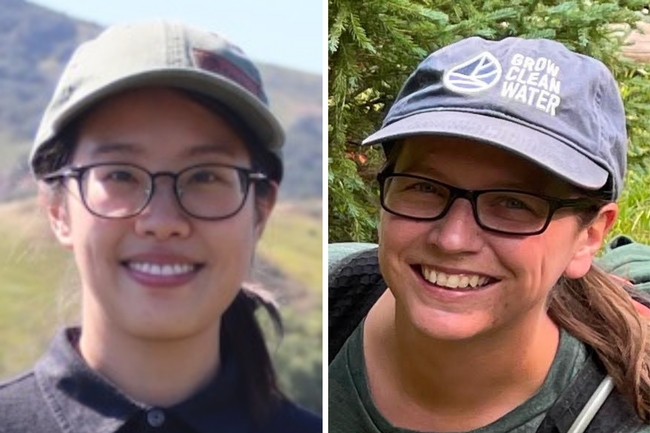
“We don't know if thrips are just so persistent and so stable in that pupal stage that maybe they will emerge unaffected,” said Kirsten Pearsons, University of California Cooperative Extension integrated pest management farm advisor for Santa Cruz, Monterey and San Benito counties. “There's just so much about their biology and ecology in the Salinas Valley that we just don't know.”
The mystery of thrips, INSV and soilborne diseases (namely Pythium wilt) is why UC Agriculture and Natural Resources assigned Pearsons to the area last November and hired Yu-Chen Wang in October as UCCE plant pathology advisor for the three counties.
“They're stepping in at a critical moment,” said Richard Smith, the region's UCCE vegetable crop production and weed science advisor who retired in January after a 37-year career. “They've gotten grants funded already – and that's just incredible. They're hitting the ground running.”
Experienced in disease diagnosis and collaboration with growers and industry partners, Wang said her pathology background – paired with Pearsons' entomology expertise – will be crucial in addressing INSV and other diseases.
“It is important for Kirsten and me to work together and provide different insights for the vector and the pathogen, respectively,” Wang said.
‘It's going to take everything to get a crop'
One priority is untangling the dynamics of INSV and Pythium wilt co-occurrence – the subject of ongoing research by JP Dundore-Arias, a plant pathologist at California State University, Monterey Bay. While the vegetables may tolerate one disease or the other, their one-two punch often deals the lethal blow.
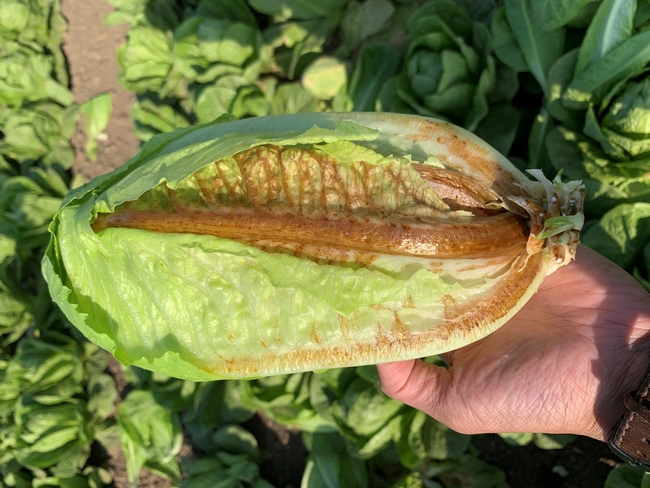
“The challenge is – which is why it's great to have Yu-Chen and Kirsten – is that we have so many problems now, whether it's Fusarium (wilt), or Verticillium (wilt), or Pythium, or INSV,” said Mark Mason, pest control adviser for Nature's Reward, which primarily grows lettuces on 5,000 acres across the Salinas Valley.
Mason said that co-infections on his crops (sometimes with three or four diagnosed diseases) make it difficult to assign monetary damages to a specific pathogen, but he noted he has seen fields with “100% loss.” According to the Grower-Shipper Association of Central California, about 11,500 acres were deemed not harvestable in 2022, representing 12% of lettuce industry acreage.
Given the gravity and complexity of the disease dilemma, Pearsons said she has been fielding calls from growers seeking new and better solutions – ways to improve existing tools, techniques borrowed from other crop systems, and additional biological or chemical means of control.
And although there are a couple of pesticides that manage the disease-carrying thrips reasonably well, growers and researchers are worried about their diminishing efficacy due to overuse. Plus, they only constitute a short-term fix.
“Managing the thrips will only reduce the amount of INSV that can get transmitted,” Pearsons explained. “You can kill 99.9% of the thrips, but you get one thrips that has INSV that enters a field, and now you have an infected lettuce plant. All of the thrips are going to come and they can spread it from there; pesticide slows things down, but it's not going to eliminate it.”
Finding disease-tolerant lettuce cultivars is a more sustainable approach. Trials conducted last year by Smith, Wang and others identified several varieties that appeared to hold up well to Pythium and INSV. While additional research could maximize their potential benefit, Wang said even the hardier cultivars will lose their resistance over time, and a multi-layered INSV strategy with “integrated management tools” is crucial.
“We realized, when this thing started happening, that we cannot spray our way out of this problem,” Mason said. “We need varieties; we need management practices; we need pesticides…it just seems like it's going to take everything to get a crop.”
Weeds key to disease control
An all-hands-on-deck approach helped control thrips-harboring weeds last winter. With fields drying out from January storms, Smith said communities must get back to weed management – with a focus on prominent weed hosts for INSV and neglected areas adjacent to farms. Hotspots of infection last year were traced to industrial lots that were overlooked during the weeding process.
“People can't lose sight of the fact that we still need to be controlling the weeds in key areas, because that's the reservoir of the virus during the winter,” Smith said. “We have to stay on task with that.”
Yet despite the diligent weed abatement, crop damage from INSV and Pythium was widespread in 2022, and Smith said it's “very possible” that high heat during the summer was a contributing factor to especially prevalent disease in fall. Thrips populations tend to thrive in warmer weather, Smith said, but much more research needs to be done to understand the basic biology of the insect, including how they acquire the virus and how they spread it.
High hopes for future
Pearsons cited the work of Daniel Hasegawa, a research entomologist with the U.S. Department of Agriculture, who leads teams in monitoring thrips populations in several locations across the Salinas Valley. Currently the counting of thrips on sticky card traps is done manually, but Pearsons and Mason mentioned the possibility of using AI and machine learning to expedite that process.
Mason said that the grower community is excited about the new technologies and ideas that Pearsons and Wang are bringing to the region. As a participant in the search for candidates to fill the advisor positions, Mason said “they were, in my opinion, by far the best fit for what we were looking for.”
“I hope they stay here for 30 years,” he added.
The new advisors both noted the palpable energy and cooperative spirit in the Salinas Valley to proactively meet the challenge.
“Looking to the past, there have been other outbreaks and diseases that they've managed to overcome,” Pearsons said. “These farmers are resilient and creative and I fully believe that lettuce will still be growing here for years to come – it might look a little different, and it might take a little bit of a painful period to get to that point, but I think that we're going to be able to come up with some solutions.”
And while there are concerns that some lettuce growers might decide to leave the region, Wang said she also believes in the industry's strong roots and rich history.
“Salinas Valley has had a beautiful climate for lettuce for so many years; there are some undeniable advantages here,” she said. “This is still the best place in the United States – and maybe the world – to grow lettuce.”
Name That Spider!
Name that spider! UC Davis professor Jason Bond is seeking a species name for a new genus of...
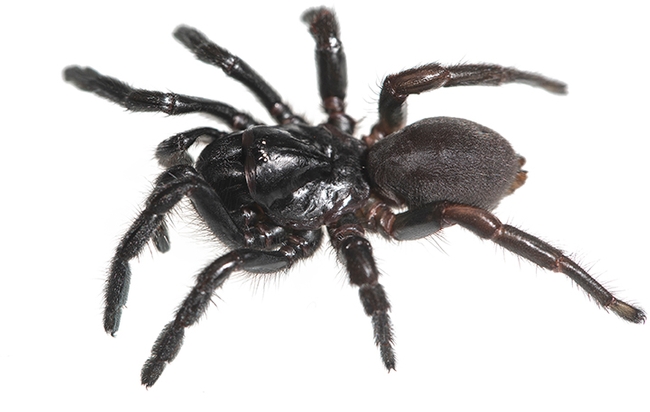
This is the female of the new genus, Cryptocteniza. (Image by Jason Bond)
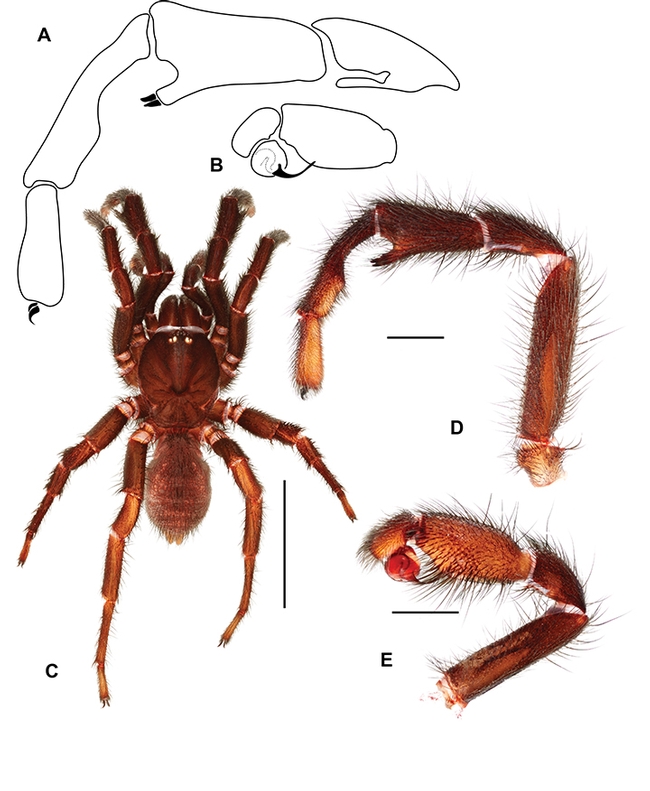
This is the male of the new genus, Cryptocteniza. (Image by Jason Bond)

UC Davis professor Jason Bond found the genus on a sandy beach at Moss Landing State Park, Monterey County. (Illustration provided by Jason Bond)
New environmental chamber to help researchers find cures for vegetable diseases

Steven Koike, UCCE advisor in Monterey County, said the chamber "will allow us to ramp up research.” The new acquisition is something like a large refrigerator in which researchers can control temperature and humidity.
“Industry in the Salinas Valley is progressive in funding research,” Koike said. “It’s not afraid to invest in solutions.”
Working to achieve healthy crops while limiting nitrate in water
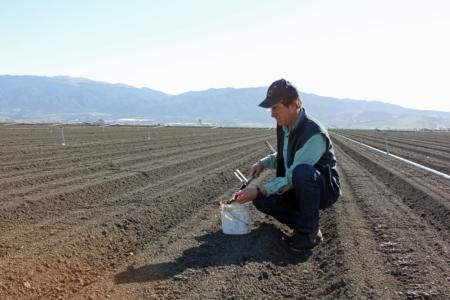
UC Cooperative Extension and Agricultural Experiment Station researchers are working with growers on fertilizer management, irrigation efficiency and other farming practices to provide options for protecting groundwater, which serves as a primary drinking water source for many rural communities. The following are some examples of ANR research and extension projects under way. The scientists’ names are hyperlinked to their contact information.
Quick nitrate test guides fertilizer management
Michael Cahn and Richard Smith, UC Cooperative Extension advisors in Monterey County, and Tim Hartz, UCCE specialist in the department of Plant Sciences at UC Davis, have developed a quick test to measure soil nitrate in the field so growers can match fertilizer rates with plant needs. The test has reduced nitrogen-loading rates by an average of 70 pounds per acre in lettuce. On-farm demonstration trials have shown that by testing the soil, growers can reduce their fertilizer use by about 30 percent. Major growers in Monterey County, who manage a significant number of vegetable acres in the Salinas Valley, have begun using the quick nitrate test in their operations. For more information read the summary article on p. 5 and fine tuning article on p. 12 of Crop Notes.
Assessing plant nutrient status
Leaf sampling is a common method of determining when a nut tree has a nutrient deficiency. Patrick H. Brown, professor in the Department of Plant Sciences at UC Davis and Agricultural Experiment Station pomologist, and his colleagues are studying other ways of assessing plant nutrient status to help almond and pistachio growers manage fertilizer applications with more precision. For more information, see Crop Nutrient Status and Demand.
NBOT aids dairies in nutrient planning
The Nitrogen Budget Optimization Tool (NBOT) is a planning tool being developed for dairies by David Crohn, professor and UC Cooperative Extension specialist in the Department of Environmental Sciences at UC Riverside. NBOT is an algorithm that uses a daily time step to represent crop nitrogen demand, nitrogen mineralization and losses from leaching, denitrification and ammonia volatilization. Typical nitrogen application charts tell how much nitrogen a crop needs during the growing season, but they do not say when the crop will need it. With NBOT, dairy operators input information about the crop they are growing, how much they expect to harvest and when they can apply manures. NBOT’s output gives an idealized management strategy that helps dairy operators decide what they should do all year round.
N-Ledger software addresses nitrogen management
A software program under development by a team headed by Marsha Campbell Mathews, UC Cooperative Extension advisor in Stanislaus County, will help dairy operators and other farmers improve nitrogen management by calculating when nitrogen applied in manure is expected to be released from organic form into a form that the crops can use. Nitrogen applications are tracked, release rates are estimated and adjusted for expected losses, and the calculated total is compared to the expected daily crop need for nitrogen. The program helps the user choose an application strategy that will meet the crop’s needs and result in the least possible amount of nitrate in the soil during periods when it is vulnerable to leaching or other losses. For more information, see the UC Cooperative Extension in Stanislaus County Manure Nutrient Management website.
Adjusting field length can reduce irrigation levels
In his research on how dairy operators can reduce water applications to their crops, Larry Schwankl, UC Cooperative Extension specialist at Kearney Agricultural Research and Extension Center in Parlier, has found that allowing less water to percolate will reduce impacts on groundwater. With shorter furrows, water applied per acre was cut nearly in half. In addition, manure water is often added to fresh water as part of dairy irrigation and fertigation practices, so being able to reduce the applied water also significantly reduces the amount of nitrogen applied. For more information, see Schwankl's Irrigation Management website.
UC helps dairy industry manage nitrogen on the farm
It is common practice for dairy operators to use cattle manure as fertilizer for their silage crops. UC Cooperative Extension advisors throughout California routinely provide reliable information to dairy operators and consultants so they can efficiently manage nitrogen on the farm and comply with pending state regulations. This information includes how to install and calibrate flow meters, how to measure nitrogen levels in manure ponds, how much nitrogen crops need and when they need it, and how to properly sample the crops that are harvested to know how much nitrogen is being removed. “We’ve developed protocols to ensure accurate information gathering, and we can share these with the dairy industry,” said Carol Frate, UCCE advisor in Tulare County. For more information, contact a UC Cooperative Extension dairy advisor.
To see other ANR projects and publications aimed at limiting nitrate leaching, please visit http://ucanr.edu/News/Healthy_crops,_safe_water.

